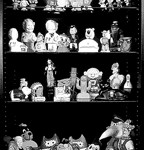
Advertising Icon Museum projected to open this year
By Natalie Horsch
You might not agree that Frosted Flakes are grrrreat, but you know Tony the Tiger. Characters such as the Pillsbury Doughboy, Jolly Green Giant, Cap’n Crunch, the Aflac duck and the Geico Gecko are all fictional, yet they are some of the most famous names out there.
These are just some of the more than 2,000 legendary advertising icons that will be featured in the Advertising Icon Museum that is projected to open its doors sometime soon here in Kansas City, Mo.
Howard Boasberg, executive director of the museum, said that the museum was expected to open this year, but the date has been pushed back as staff members recruit more donors to fund the project.
The museum’s mission is to educate and enhance the public’s appreciation of advertising and product branding through the use of advertising icons and fictional characters, and to explore how they reflect social and cultural values, according to the museum’s website. It will illustrate how certain icons came about, and how they have become such a big part of pop culture.
Boasberg said it will be home to the largest known three-dimensional advertising icons.
Advertising icons can influence members of society without their even realizing it. Greg Harrell, professor of journalism, said one may buy a certain item because of how they feel toward it, an emotional connection that formed because of the icon or mascot for that product. The Kool-Aid Man, Mr. Peanut and the Michelin Man, all set to be in the museum, have influenced the consumer because they are cute, funny or strong.
There are many items that are household names, not necessarily based on the quality of the item, but on the advertising icon behind it. The way one perceives the icon can affect the products one chooses to buy.
“Perception is reality,” Harrell said.
Advertising icons can help the consumer feel a connection to the product. They give the product a face and help make it relatable to the consumer. Sometimes one thinks of the icon for the brand before he thinks of the product.
“Advertisers look to personify their products, and advertising icons help to do just that,” Harrell said. “They give identity to the brand and connect the consumer to the brand.”
Harrell said one of his favorite advertising icons was Speedy Alka-Seltzer because he was warm and friendly.
Ashley Griswold, a student at KU, said she remembers when watching television as a child and the Pillsbury Doughboy commercial would come on, she would always do the laugh at the end when the Doughboy was poked in the stomach.
“Whenever we would make the biscuits, we would always make that laughing noise and shake just like he did,” Griswold said. “He was just so darn cute.”
Harrell said advertising icons have become just a part of everyday life. The museum will be a place where you can not only go to see, but also learn about all of these icons.
“It is a museum of ideas,” Boasberg said. “It is a living museum that will continue to evolve with the times.”
Contact Natalie Horsch, special to the Ledger, at [email protected].





















